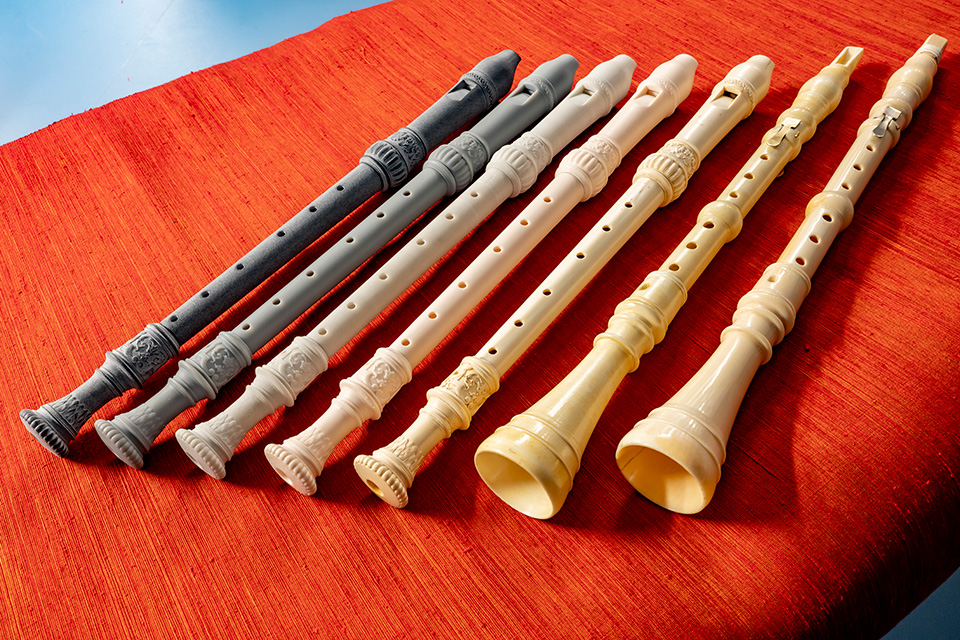Innovative 3D models of historical instruments protect and promote rare instruments to new audiences
Thursday 22 February 2024
3D models of eight rare woodwind instruments protect against conservation concerns around the playability of historical instruments due to their fragility, allowing greater engagement opportunities for Royal College of Music (RCM) students, professional musicians and Museum visitors.
Using world-leading 3D printing technology, the Royal College of Music Museum has created copies of eight woodwind instruments from the collection, making accurate reproductions that are suitable for professional performance. The copies provide opportunities to play these instruments much more extensively and expand understanding, as well as broadening the experience for visitors through touch and sound which are so key to a musical collection.
Spanning from the mid-17th to the mid-18th centuries, the instruments include three recorders, a flute, a clarinet, an oboe and a Renaissance cornett, several of which are made entirely of ivory. Visually identical to their original counterparts, the copies have been reverse engineered to virtually repair any cracks, dents and imperfections. Moreover, the ability to print several copies creates an opportunity to use the instruments in ensemble performances which would have been normal at the time when the instruments were made but are otherwise impossible today.
[image1]
Professor Gabriele Rossi Rognoni, Curator of the Royal College of Music Museum, commented: ‘The recent advancements in 3D scanning and printing technology are giving Royal College of Music students – and musicians at large – the unique opportunity to perform on accurate reproductions of historical instruments that are too fragile and precious to be used extensively. I believe that this project, combined with the musical excellence of the RCM’s Historical Performance faculty, will open new perspectives in the musical possibilities offered by early instruments for education and performance.’
BMus Historical Performance student Larli Davies has already been playing the instruments. She added: ‘Playing both the original Denner recorder and the 3D-printed replicas has completely changed the way I look at historical repertoire. It’s particularly rewarding to perform Telemann with these recorders, as they’re so like the instruments he would have played. Their colours, dynamics, and the way they speak are so unique and intricate – it makes the shape of the music much clearer.’
Professor Ashley Solomon, Royal College of Music Head of Historical Performance, commented: ‘This new and exciting project will enable our current and future Historical Performance students to study the characteristics and particular idiosyncrasies that exist in original wind instruments that they would otherwise not be able to play for any length of time. As part of their Historical Performance journey at the Royal College of Music they will have to develop a more flexible approach to playing these exact copies. We hope that this will lead to a greater understanding of why particular instrument builders made these models for specific repertoire at a very specific time and inspire a greater curiosity when performing this music.’
The copy of the Denner recorder will be performed in a unique recording of Handel’s Cantata Tra le fiamme with award-winning period ensemble Florilegium, directed by Professor Ashley Solomon. RCM alumna soprano Rowan Pierce will feature on the recording alongside RCM professor Reiko Ichise performing on a viol from the Kessler Collection, blending old and new instruments in a rare juxtaposition to be released on Channel Classical later this year.
The instruments will be premiered at the Royal College of Music on 18 March in a concert curated by Professor Ashley Solomon and with performers including RCM Director Professor Colin Lawson, Dr Ingrid Pearson and several students. The concert concludes an international conference held at the RCM examining the application of 3D printing to the preservation, documentation and accessibility of musical heritage.
[video1]
The project, led by Professor Gabriele Rossi Rognoni in collaboration with Professor Gabriele Ricchiardi at the University of Turin and a team at the Natural History Museum, has been funded by a grant of £33,000 from the DCMS/Wolfson Museums and Galleries Improvement Fund as part of their £4 million fund to improve displays, protect collections and make exhibitions more accessible to visitors.
One of the largest collections of its kind in the world, the Royal College of Music Museum houses over 14,000 musical items. It reopened in October 2021 after a £4.8 million redevelopment, one of the largest ever investments in a music museum in the UK, and includes an accessible learning space, the Weston Discovery Centre, and the Wolfson Centre in Music and Material Culture, which will continue working on the use of 3D printing in musical education and research. The RCM Museum is free to visit and is open Tuesday–Friday, 10.15am-5.45pm and Saturday–Sunday, 11am-6pm. The Museum also hosts a series of intimate concerts featuring RCM musicians performing on and amongst the artefacts. These take place on Friday lunchtimes and tickets can be booked online.
Find out more about the concert featuring the new instruments on 18 March 2024 or visit the project page for further information.
Find out more about studying Historical Performance at the Royal College of Music.
This news item appears in the 2024 Spring edition of Upbeat magazine.
Read the latest edition of Upbeat








